
Official Edgar Rice Burroughs Tribute and Weekly Webzine Site
Volume 8092


Tarzan and the "Psychology of
Truth"
by Alan Hanson


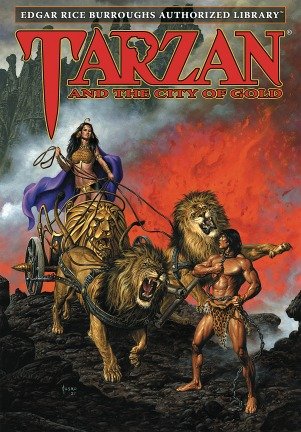
“Tarzan
remained silent. He would not promise, and so he did not speak.”
The
truth, though, is that
Tarzan did lie
occasionally. Certainly, he did not do so as often as the average man,
but he
was not above employing strategic falsehoods when useful in what he
considered
to be noble causes. Before pointing out some examples of Tarzan’s lies,
let’s
set a couple of ground rules. First, let’s allow that Tarzan was
incapable of
lying prior to learning to speak human language. In March 1909, at the
age of
20, Tarzan, who had taught himself to read, wrote a note to Paul
D’Arnot, asking
him to “teach me the language of men.”
Tarzan quickly picked up both
French and
English, making him then vulnerable to the sin of telling lies.
Second,
for a statement to be a
lie, not
only does what the speaker said must
be untrue, but he must also know that
it’s untrue. At times Tarzan made statements that he thought were true
at the
time, but later proved to be false. Being mistaken does not make one a
liar.
Tarzan’s First Lie?

In
the closing pages of Tarzan of Apes, the ape-man,
standing in
a railroad waiting room, read a cablegram from his friend Paul D’Arnot
in
Paris. It read, “Finger prints prove
you Greystoke, Congratulations.”
Later,
William Clayton asked Tarzan, “If
it’s any of my business, how the
devil did
you get into that bally jungle?”
We
can excuse a lie at times if
it is said
to spare someone from learning a painful truth, and that could have
been one of
those times. However, it is possible that, despite the cablegram,
Tarzan still
believed at the time that his mother was an ape. He had dismissed
D’Arnot’s
previous assertions that the dead John and Alice Greystoke must have
been his
parents, and, after just a few months in civilization, Tarzan easily
could have
given no credence to a new forensic science like fingerprint
identification. So
it’s possible that he believed the statement he made at the end of Tarzan of the Apes was true.
Deceiving
Natives
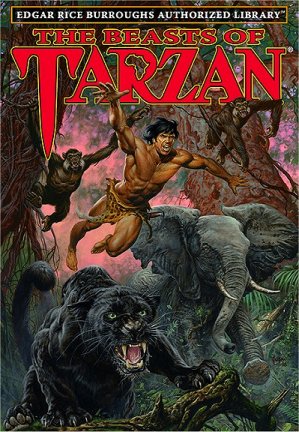


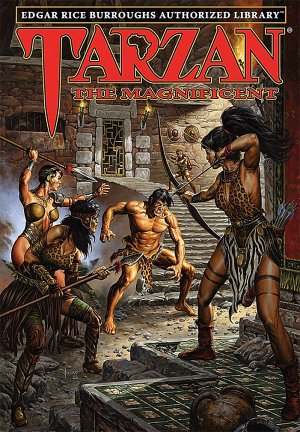
Tarzan’s
first bona fide lie
occurs in The Beasts of Tarzan. While the
ape-man
was pursuing the villainous Nicholas Rokoff, he came upon a native
village. He
wanted to question its inhabitants concerning the white men he was
pursuing,
but he “was at a loss as to how he
might enter into communication with
these people
without either frightening them or arousing their savage love of
battle.” So,
he came up with a plan. He climbed into a tree hanging above the
village and
made sounds like a panther. Then he descended and hustled around to the
village
gates. There he yelled out to the scared natives within that he would
drive the
panther away if they would let him in the village and answer his
questions.
When the natives required that he drive the menacing cat away first,
Tarzan
returned to the tree, and, with great commotion and screams, pretended
to chase
the panther away. He then returned to the village gates and voiced an
obvious
lie: “I have driven Sheeta away. Now
come and admit me as you promised.”
No
harm, no foul, one might
say, but it was
certainly a lie, told to deceive fearful natives whom Tarzan knew would
believe
it. In ERB’s Tarzan stories there are several other incidents in which
the
ape-man purposely took advantage of fearful natives by lying to them.
One
example occurs in Tarzan and the Golden Lion. With a
woman under his
protection,
Tarzan entered a native village in a valley behind Opar. “I am going to
bring
my mate into your village and you are going to hide her, and feed her,
and
protect her until I return,” he told the scared natives. It was
a lie
when he
referred to the woman accompanying him as his “mate.” In fact, it was
not Jane,
but rather La, Queen of Opar. ERB explained why Tarzan felt the need to
tell
this particular fib.
“He
had thought it best to describe La as his mate, since thus they might
understand that she was under his protection, and if they felt either
gratitude
or fear toward him, La would be safer.”
Okay,
it was a harmless, little
lie, but
nevertheless, it was a lie, again challenging the notion that Tarzan
“never
lied.”
Tarzan
also lied to natives on
other
occasions. In Tarzan and the Lost Empire,
the ape-man again took advantage of superstitious natives by stretching
the
truth. After Tarzan had been captured and left bound in a hut, Nkima
dropped in
for a visit. When the native sentry asked Tarzan to whom he was
talking, the
ape-man replied, “That was the ghost
of your grandfather. He came to
tell me
that you and your wives and all your children would take sick and die
if
anything happens to me.”
In
Tarzan’s
Quest, the ape-man lied
again to take advantage of fearful natives.
Pretending to be a member of a tribe of white savages who abducted
native
women, Tarzan threatened a scared native, “One sound and you die; I am
a
Kavru.” (The Kavru were a savage white tribe whose warriors
stole
native
girls.)
In
Tarzan
the Magnificent, the
ape-man again lied about his identify,
pretending to
be an evil spirit.
“Instantly
a head was thrust from an open window and a man’s voice demanded, ‘What
are you
doing there? Who are you?’”
“‘I
am Daimon,’ replied Tarzan in a husky whisper. Instantly the head was
withdrawn
and the window slammed shut. Tarzan, quick witted, had profited by
something
that Gemnon had told him — that the Athneans believed in a bad spirit
that was
abroad at night seeking whom it might kill. To Daimon they attributed
all
unexplained deaths, especially those that occurred at night.”
Deceiving Meriem
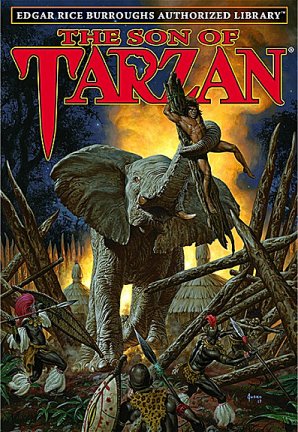
In
The
Son of Tarzan, the ape-man lied to Meriem, his future
daughter-in-law, when
he found her wandering in the wild. When she insisted on searching for
someone
she called “Korak,” Tarzan
promised to help her. “I shall not harm
you,” he
told her. “I only wish to discover if
you have fever … If you are well
we will
set forth in search of Korak.” It was a lie. Tarzan never
intended to
search
for the mysterious “Korak,” but instead wanted to lead Meriem to his
African
home.
“By
degrees he turned the direction of their way more and more eastward,
and
greatly was he pleased to note that the girl failed to note any change
was
being made … On the fifth day they came suddenly upon a great plain and
from
the edge of the forest the girl saw in the distance fenced fields and
many
buildings. At the sight she drew back in astonishment. ‘Where are we?’
she
asked, pointing. ‘We could not find Korak,’ replied the man, ‘and as
our way
led near my douar I have brought you here to wait and rest with my wife
until
my men can find your ape or he finds you.’”
The Son of
a God
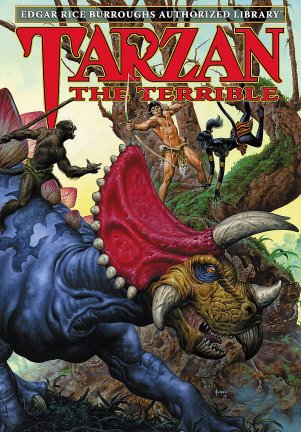
All
of those lies told by
Tarzan were trifles
compared to the colossal lie the ape-man told and perpetuated in Tarzan the Terrible. In search of
his
missing wife, Tarzan boldly and openly walked into the Pal-ul-don city
of A-lur
and announced he had just arrived from heaven. “I come neither as a
slave nor
an enemy; I come directly from Jad-ben-Otho.” Escorted to the
king’s
palace, Tarzan
repeated the colossal assertion. “I
have come from the country of
Jad-ben-Otho
… Take me to the king at once lest the wrath of Jad-ben-Otho fall upon
you.”
When
a guard reached out to
grab an arm,
Tarzan doubled-down on his big lie. “Stop!”
he cried, “who would dare
touch the
sacred person of the messenger of Jad-ben-Otho? Only as a special mark
of favor
from Jad-ben-Otho may even Ko-tan himself receive this honor from me.
Hasten!
Already now have I waited too long! What manner of reception the Ho-don
of
A-lur would extend to the son of my father!”
The
son of their god! As
audacious was that
escalation of Tarzan’s big lie, ERB explained that the ape-man had
actually
considered claiming he was the top deity himself. “At first Tarzan had
been
inclined to adopt the role of Jad-ben-Otho but it occurred to him that
it might
prove embarrassing … it had suddenly occurred to him that the authority
of the
son of Jad-ben-Otho would be far greater than that of an ordinary
messenger of
a god.”
Tarzan
continued to build upon
his tall
tale.
“You
know the power of Jad-ben-Otho; how his lightnings gleaming out of the
sky
carry death as he wills it; how the rains come at his biddings, and the
fruits
and berries and the grains, the grass, the trees, and the flowers
spring to
life at his direction; you have witnessed birth and death, and those
who honor
their god honor him because he controls these things. How would it fare
then
with an imposter who claimed to be the son of this all-powerful god?
This then
is all the proof that you require, for as he would strike you down
should you
deny me, so would he strike down one who wrongfully claimed kingship
with him.”
Tarzan
brazenly kept adding
layers to his
fictitious claims. He insisted that “none
may sit upon a level with the
gods,”
(meaning him) in the temple and he informed Lu-don, the high priest,
“that the
blood of a false priest upon the altar of his temple is not displeasing
in the
eyes of Jad-ben-Otho.”
Later
Tarzan tried to use his
self-exalted
status in A-lur to soften the strict tenants of A-lur’s long-standing
religion.
“There
is but one god, and he is the god of the Waz-don as well as of the
Ho-don; of
the birds and the beasts and the flowers and of everything that grows
upon the
earth or beneath the waters. If Pan-at-lee (a slave) does right she is
greater
in the eyes of Jad-ben-Otho than would be the daughter of Ko-tan should
she do
wrong.”
Even
after Korak arrived to
save his
parents’ lives in the temple at A-lur, Tarzan continued to claim he was
the son
of their god. When Ja-don, A-lur’s new leader, asked Tarzan to transmit
to his
people the wishes of his father, Tarzan, still pretending to be the son
of
their god, responded.
“Your
problem is a simple one if you but wish
to do that which shall be pleasing in the eyes of god. Your priests, to
increase their power, have taught you that Jad-ben-Otho is a cruel god;
that
his eyes love to dwell upon blood and upon suffering. But the falsity
of their
teachings has been demonstrated to you today in the utter defeat of the
priesthood.
“Take
then the temples from the men and give them instead to the women that
they may
be administered in kindness and charity and love. Wash the blood from
your
eastern altar and drain forever the water from the western.
“Once
I gave Lu-don the opportunity to do these things but he ignored my
commands,
and again is the corridor of sacrifice filled with its victims.
Liberate these
from every temple in Pal-ul-don. Bring offerings of such gifts as your
people
like and place them upon the altars of your god. And there he will
bless them
and the priestesses of Jad-ben-Otho can distribute them among those who
need
them most.”
When
Tarzan, Jane, and their
son soon left
A-lur and Pal-ul-don, they left behind a new religion based upon a
framework of
falsehoods Tarzan had spread among the people. The people of A-lur in
Pal-ul-don would forever see the image of Tarzan of the Apes when they
imagined
the son of their god.
“The
king and many warriors and a multitude of people accompanied them
beyond the
limits of A-lur and after they had bid them good-bye and Tarzan had
invoked the
blessings of God upon them the three Europeans saw their simple, loyal
friends
prostrate in the dust behind them until the cavalcade had wound out of
the city
and disappeared among the trees of the nearby forest.”
The Forest
God of Chichen Itza


In
Tarzan
and the Castaways the ape-man one-upped his false caricature as
the
son of
a god in Tarzan the Terrible. The
ape-man told his most audacious and final lie, when he declared himself
Che,
Lord Forest, an actual god who came to earth in mortal form. As had the
people
of A-lur, the population of Chichen Itza bought into Tarzan’s false
claims just
because he was able to swim around in a volcano lake from dawn until
noon
without drowning. When Tarzan arose from the water, “the people fell to
their
knees before him and supplicated him for forgiveness and for favors.”
“I came to earth in the form of
a mortal,”
he told them, “to see how you ruled
my people of Chichen Itza. I shall
come
again someday to see if you have improved. Now I go.” As he rode
Tantor
into
the forest, Tarzan turned to see the people of Chichen Itza knelling
with their
faces pressed down. An English woman who witnessed the scene predicted,
“Their
great-great-grandchildren will hear of this.”
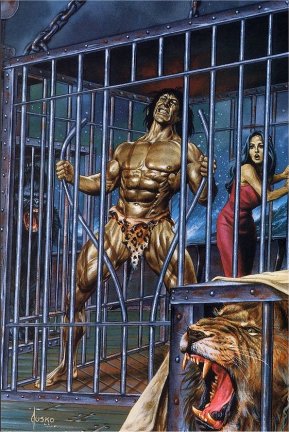
After
describing how Tarzan
reduced a white
African guide to subservience in Tarzan
and the Champion, ERB added the following observation about
Tarzan.
Tarzan’s
inherent “psychology
of the truth”
told him he could spread falsehoods if he knew the people who heard
them wanted
to believe they were true, and if they then led to successful action.
The lies
he told natives achieved both goals, as did the lie he told Meriem.
Certainly,
the lies he told the people of A-lur and Chichen Itza were welcomed by
the
population and resulted in positive changes in those societies for
generations
to come.
THE END
ERB, Inc. Authorized
Editions
https://www.ERBzine.com/craft



![]()

![]()
BILL
HILLMAN
Visit
our thousands of other sites at:
BILL
and SUE-ON HILLMAN ECLECTIC STUDIO
ERB
Text, ERB Images and Tarzan® John Carter® Priness of Mars®
are ©Edgar Rice Burroughs, Inc.- All Rights Reserved.
All
Original Work ©1996-2025 by Bill Hillman and/or Contributing
Authors/Owners
No
part of this web site may be reproduced without permission from the
respective
owner.